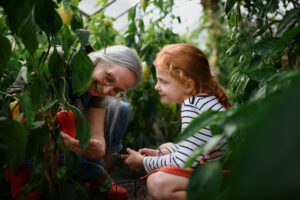
It can take up to 1000 years for plastic to break down. 1 million sea birds die each year from plastic entanglement and every minute, a garbage truck worth of plastic is dumped into the ocean. Whilst these statistics are daunting, it is important that children and adults realise how much damage plastic can do to the environment. Sustainability can be a difficult concept to grasp but having conversations about the importance of taking care of our planet and how we can do that in our everyday actions, is not only an important conversation for children to have but serves as a good reminder to we adults. There are many fun ways that we can incorporate learning about sustainability into our daily lives.
1. Teach recycling
The number in the triangles of plastic items, are codes that allow manufacturers to categorise and help us to identify what can be recycled. Numbers 1, 2, 5 and 7 are common plastics that can be recycled, however generally speaking numbers 3, 4 and 6 cannot. Before you purchase an item, ask your child to check the number to see if it can be recycled, if not, look for alternatives such as glass.
2. Say no to bin-liners!
The next time you head to the supermarket, don’t forget your reusable shopping bag! Reusable shopping bags are not only good for the environment, but they also often hold more than a plastic bag and come in fun colours so that everyone in the family can have their own! If you are worried about what you will use to line your rubbish bin, have you ever considered using nothing but the bin itself? Each time you take out your rubbish, give the bin a wash and re-use! It will only take an extra minute and is a great way to notice how much rubbish your family is producing.
3. Refuse and re-use
Refusing and re-using doesn’t need to stop at plastic bags; see if you can come up with a list with your children about products that you can choose to say no to. Think plastic straws, take away coffee cups and plastic bottles. All these items we use out of habit but remember they haven’t been around for long! Explain to your children what you used to do before we had these items.
4. Recycle soft plastics
Did you know that soft plastics such as plastic bags, chip packets, chocolate packets, cling wrap, bread bags, frozen food bags and many more, cannot be put into your recycling bin? Luckily the Love NZ Soft Plastic Scheme has placed soft plastic recycling bins at several supermarkets, these plastics are used to make things like park benches and fitness circuits at playgrounds! Simply create another ‘bin’ at home for all your soft plastics and take them with you when you next head to the shops! Educate your children to recycle responsibly and leave less waste.
5. Read
Read storybooks to your children that are focused on the sustainability of our planet. Some of our favourite books are:
- I want to be green, but what does that mean? Jill Dunn
- The boy and the Dolphin – Robyn Kahukiwa
- Here we are: Notes for living on planet earth – Oliver Jeffers
- What if there were no bees? Suzanna Slade
6. Reduce water use
It can be hard for children to realise that water is a limited resource. The average New Zealand family uses 250 litres of water per person every day, which is a huge amount considering a bath holds around 80 litres! It can be difficult for children to imagine how much water that is, so use a litre bottle of milk and ask them to imagine placing 80 of them into a bath! Explain to them that showers are a more sustainable option, however these can also use a large amount of water. Framing water conversations as a challenge makes it fun for children and is a great way to reduce your water consumption. Create a score board and time your kid’s showers, then get them to reach towards a personal record for the shortest shower in the house!
7. Plant a garden together and visit a local farm

Ask your child about their favourite vegetables, and then go to your local plant store to pick out the seeds. You can talk about the circle of life on Earth – how plants “eat” broken down animal matter from the soil, animals eat the plants, other animals eat those animals, and those animals die and decay to start the cycle again. They can learn how important soil microbes and fungi are to a healthy soil, and how a farm with both animals and plants creates far more biodiversity than just crop farming. They can learn how well-managed animals are essential for healthy soil and how they can help put carbon back into the plants and the soil, offsetting any methane emissions. See the Sustainable Dish website for cool details on holistic and regenerative farming.
Planting a vegetable garden teaches children how plant food grows and visiting a local farm shows your children where nutrient-dense animal foods come from. This also teaches them about the different seasons and how special food is. Planting vegetables and meeting the farm animals also encourages a healthier relationship with food and nature and teaches responsibility. If you don’t have room for a vegetable garden, take your kids to the farmers’ market and pick out vegetables together so that they can see a variety of seasonal produce.
8. Start composting
When food is mixed with other rubbish in the landfill, it doesn’t compost, as waste needs air to break down. A simple compost bin can turn all your kitchen waste into compost for your garden soil. This will not only be beneficial for your garden, but is a great way to put nutrients, and not waste into the earth. If your kids like getting their hands dirty, compositing is a great hands-on activity! If compositing seems complicated, head to the Compost Collective to find the right composting system for you. They can learn how plant food waste is a big contributor to methane emissions, so wasting food is to be avoided, where possible.

9. Recycle inorganics
Did you know that many local councils will accept items such as kettles, irons, garden tools, computers, phones, and DVD players? If you have inorganic material that you wish to get rid of, don’t put it in the bin! Teach your children how to run a garage sale, take items to a donation store or contact your local refuse centre and teach your children how every purchase you make has long term effects on the planet. Let the spring clean begin!
10. Quality over quantity
Fast-fashion is a problem and too often people are valuing the quantities of clothing over quality. Children often grow out of clothing before they will wear them out, so choose higher quality items that they can wear more often. Once children have grown out of clothes, create a community clothing exchange and involve them in the initiative. Invite their friends from school so that they can share their most loved items with their friends. You can also create donation piles so that children learn how used items can help the community. Teaching children that clothing is not disposable, can help them to reduce the likelihood of fast-fashion consumption in the future.
Children learn by watching the world around them. So, the best way to educate them about sustainability is to lead by example. It is the little actions every day that can make an impact on their world, and the world around us. When we teach our children to care about sustainability, we are teaching them skills that will last for a lifetime.
TAPSPP1340

